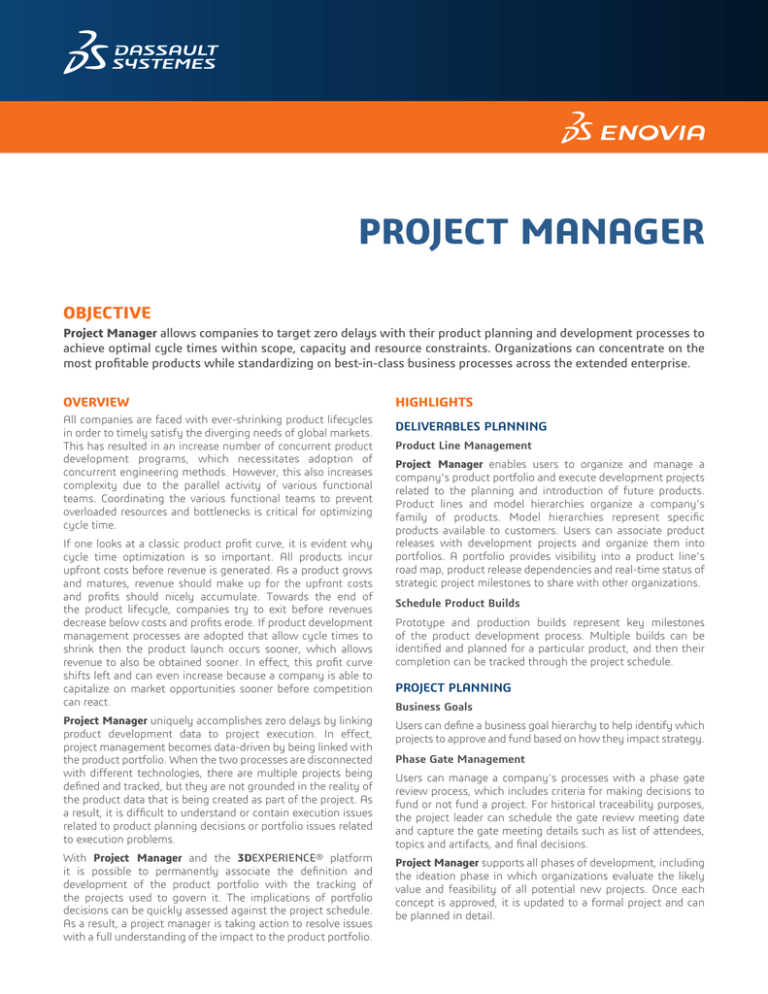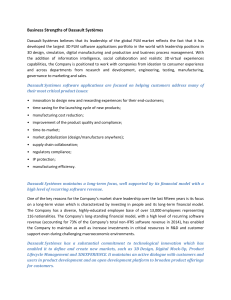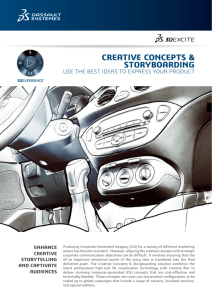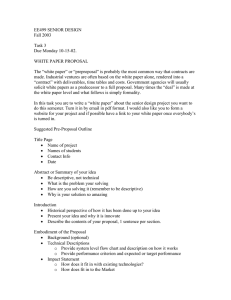
PROJECT MANAGER
OBJECTIVE
Project Manager allows companies to target zero delays with their product planning and development processes to
achieve optimal cycle times within scope, capacity and resource constraints. Organizations can concentrate on the
most profitable products while standardizing on best-in-class business processes across the extended enterprise.
OVERVIEW
All companies are faced with ever-shrinking product lifecycles
in order to timely satisfy the diverging needs of global markets.
This has resulted in an increase number of concurrent product
development programs, which necessitates adoption of
concurrent engineering methods. However, this also increases
complexity due to the parallel activity of various functional
teams. Coordinating the various functional teams to prevent
overloaded resources and bottlenecks is critical for optimizing
cycle time.
If one looks at a classic product profit curve, it is evident why
cycle time optimization is so important. All products incur
upfront costs before revenue is generated. As a product grows
and matures, revenue should make up for the upfront costs
and profits should nicely accumulate. Towards the end of
the product lifecycle, companies try to exit before revenues
decrease below costs and profits erode. If product development
management processes are adopted that allow cycle times to
shrink then the product launch occurs sooner, which allows
revenue to also be obtained sooner. In effect, this profit curve
shifts left and can even increase because a company is able to
capitalize on market opportunities sooner before competition
can react.
Project Manager uniquely accomplishes zero delays by linking
product development data to project execution. In effect,
project management becomes data-driven by being linked with
the product portfolio. When the two processes are disconnected
with different technologies, there are multiple projects being
defined and tracked, but they are not grounded in the reality of
the product data that is being created as part of the project. As
a result, it is difficult to understand or contain execution issues
related to product planning decisions or portfolio issues related
to execution problems.
With Project Manager and the 3DEXPERIENCE® platform
it is possible to permanently associate the definition and
development of the product portfolio with the tracking of
the projects used to govern it. The implications of portfolio
decisions can be quickly assessed against the project schedule.
As a result, a project manager is taking action to resolve issues
with a full understanding of the impact to the product portfolio.
HIGHLIGHTS
DELIVERABLES PLANNING
Product Line Management
Project Manager enables users to organize and manage a
company’s product portfolio and execute development projects
related to the planning and introduction of future products.
Product lines and model hierarchies organize a company’s
family of products. Model hierarchies represent specific
products available to customers. Users can associate product
releases with development projects and organize them into
portfolios. A portfolio provides visibility into a product line’s
road map, product release dependencies and real-time status of
strategic project milestones to share with other organizations.
Schedule Product Builds
Prototype and production builds represent key milestones
of the product development process. Multiple builds can be
identified and planned for a particular product, and then their
completion can be tracked through the project schedule.
PROJECT PLANNING
Business Goals
Users can define a business goal hierarchy to help identify which
projects to approve and fund based on how they impact strategy.
Phase Gate Management
Users can manage a company’s processes with a phase gate
review process, which includes criteria for making decisions to
fund or not fund a project. For historical traceability purposes,
the project leader can schedule the gate review meeting date
and capture the gate meeting details such as list of attendees,
topics and artifacts, and final decisions.
Project Manager supports all phases of development, including
the ideation phase in which organizations evaluate the likely
value and feasibility of all potential new projects. Once each
concept is approved, it is updated to a formal project and can
be planned in detail.
Key Benefits:
Schedule Management
Users can decompose complex product development activities
into smaller manageable sub-projects. Users can then define
schedules to organize global project teams into phasegate activities that take into consideration assigned project
members’ roles and non-working days. Tasks can be copied
from projects or from project templates, including copying
partial task structures. Project Manager provides bi-directional
integration to Microsoft Project for project managers that
prefer using a Microsoft Project user interface for editing
schedule information.
• Connect project deliverables with the product
portfolio to accurately communicate how a
market opportunity will be met.
• Coordinate scope, schedule and resources to
deliver the product portfolio within business
constraints.
• Govern the project “invisibly” with in-context task
management.
• Reveal risks based on real-time information.
Gantt Chart
Users can view the project schedule graphically. The phases and
tasks are displayed as bar charts based on the timelines, and
the milestones and gates are marked on it as well. It illustrates
the start and end dates, and also displays the dependencies
between tasks. It provides for an easy way to study the whole
project schedule. Users can also edit the schedule from the
Gantt view.
Engineering Project Management
For companies using Collaborative Innovation, it is possible
to monitor design activity and navigate all project information
from CATIA® using Project Manager. This allows access to
outputs from design from the corresponding project tasks.
Since Project Manager and Collaborative Innovation both
run on the same technology platform , users can search for
and associate engineering data as deliverables to assigned
project tasks easily. Engineering tasks can be created as part
of the project’s schedule and are accessible immediately to the
designer within his design environment.
Flexible Work Calendars
The work week, working hours and holidays vary across the
globe. It also varies based on the type of task being executed and
across organizations. The work hours per day in a week can also
vary. Project Manager provides the ability to create flexible work
calendars based on organizational and regional factors.
Exceptions can be created on a calendar. Exceptions can be
for holidays or for work days and can recur on daily/weekly/
monthly/annual basis. There can be a start and end effectivity
date for each exception. A practical use of exceptions is for
handling production cutovers that require extra work on a
weekend of longer than usual hours for a set period. The same
use of exceptions may be required if development or production
is behind schedule. The company may choose to implement
mandatory overtime temporarily.
Each task can be on a different calendar based on the location
of the task assignee or the type of task. If the task does not
have a calendar, then the calendar associated to the user’s
location is used, and if the location does not have a calendar
the default project calendar is used. Tasks are scheduled based
on the calendar to provide an accurate schedule that reflects the
real life view for work plans.
Advanced Resource Management
Project Manager enables companies to optimize global resource
staffing plans for strategic projects and reduce cycle times by
implementing best-in-class business processes.
Users can define project resource plans by project phases or over
a project timeline in either weekly or monthly intervals. Plans
are submitted to functional group managers for fulfillment.
During the resource planning definition process, users can
define the estimated resource costs. Each submitted resource
request identifies the business skills to ensure that the right
people are assigned to the project resource request.
Functional group managers have real-time visibility to all
submitted requests in order to assign available people within
their organization or to even reject a request. Functional
managers can also leverage a number of resource planning
reports to help increase resource utilization, eliminate
bottlenecks and improve resource assignment decisions.
Project Financials
Users can define a financial plan for each project. The financial
plan includes the project budget and project benefit. The project
includes project capital and expense categories and items,
along with actual costs. The project leader can also define
the financial benefits the project will deliver over a defined
timeline. Users have the ability to toggle between multiple
monetary currencies.
Project Access
The 3DEXPERIENCE platform security model provides a
common, consistent access model across all DS solutions. This
applies to project data as access can now be defined not only
for individual users, but also as a combination of organizations
and collaborative spaces. Access can not only be defined on a
project itself but also on individual objects within projects. For
example, a given WBS phase can be made visible for a supplier
for review or authoring.
The richness of the security model allows scaling from very
simple SMB scenarios to OEM/Suppliers extended enterprise
access needs.
All project content and deliverables are managed and stored
securely within controlled folder and subfolder structures.
Within a project, each folder and file maintains additional levels
of security.
Lifecycle controls establish folder content baselines as
a means of measuring project performance and historical
references. Team members can establish a single environment
for managing and sharing all project information —not just
documents. By subscribing to folder and document events,
members can become informed immediately as changes and
additions occur. Reports provide a consolidated list of projectrelated content from either the work breakdown structure or
from the folder structure.
Critical To Quality (CTQ)
To ensure that projects meet customer requirements, project
teams can define and measure a project’s CTQs. These are the
key measurable characteristics in which performance standards
or specification limits of a product or process must be met in
order to satisfy customer needs.
PROJECT EXECUTION
Experiments
Project experiments allow users to create alternate plans for
projects and check planning alternatives without affecting the
master plan. Multiple alternatives can be created for a project
in which the users can author the WBS with the same tools
as for the master plan. The plan alternatives can be compared
with the master plan to choose the best option. When settled
on an option, users can push the experiment changes to the
master plan.
Project Change Management
To control changes to a project plan, a change process between
the master project and the experiment project is now available.
Users can now request project changes by raising issues and
associating experiments to these issues. The synchronization
of the experiment to the master project requires approval of
the changes from a project leader. The issue can be closed on
experiment merge. Project leaders have now full control of the
planning changes as the change process is now formalized
through issues, experiments and approvals.
Task Deliverables
As tasks are assigned and being worked, task deliverables
should be associated and managed in the context of the
task. As a deliverable is promoted through its lifecycle, the
system automatically updates the task status. After the
tasks are completed, project folders store and categorize the
deliverables for access controls and increased visibility. To keep
task deliverables on schedule, project leaders can configure
automatic reminders of upcoming or late tasks that project
members will receive in their company email. Tasks can also
require a review with the project manager or be automatically
completed when the task assignee indicates it is 100% done.
Issue / Risk Management
Issues are real incidents, inquiries, or problems that impact a
project negatively, and risks are anything that can potentially
impact a project negatively. Issue management provides a
context for capturing, tracking, and closing issues in the context
of a project. Issues are identified, captured, classified, and
assigned to project members for resolution. Risk management
enables project teams to identify, quantify, analyze, and
mitigate project risks. During the analysis process, risks need
to be assessed and quantified in two dimensions. These two
dimensions are impact and probability with ranges from 1-5.
These dimension values help minimize these potential negative
impacts by determining each risk priority and clarifying which
project risks need mitigation. Risks can be copied from one
project to another project.
Project Meeting Traceability
Users can capture meeting details to maintain artifacts for
historical references. Managers can define meetings, and track
who was invited and who actually attended. Agenda topics can
be added to meetings with time durations allocated for each
topic and associated document attachments for discussion.
Issues that need further follow up and recorded decisions are
stored as an outcome of the meeting.
Weekly Time Tracking
Users can enter hours worked on a project or a task during
the week, and submit them to either the functional manager
or project manager for approval or rejection. Project Manager
provides time reports by project phase or by project member
to track worked hours for assigned tasks. By capturing a user’s
time throughout the week in a time sheet, the project manager
has accurate status information, can project future progress,
identify potential risks, and take the necessary actions to
readjust the schedule or resources.
My Calendar
The “My Calendar” view helps users to manage their
assignments by providing a consolidated view of Project WBS
Tasks, Risks, Issues, Meetings and Route Tasks. The user
assignments can be visualized in daily, weekly and monthly
views based on task due date and start date. From these views
the users can directly access to assignment properties through
right mouse buttons and work on their tasks.
Project Intelligence
Users can add feeds on projects and tasks within a 3DDashboard.
With these widgets, the users can monitor project related
information in context of other sources of information and from
there decide the course of actions to be taken. The available
widgets are “My Projects” and “My Tasks”, which monitor
projects that the user is involved in as well as assigned tasks.
Tagging services allow users to quickly filter widgets and tables
content based on already defined tags and to enrich project
information with their own tags.
PROGRAM DRIVEN CHANGE CONTROL
Change Projects
Project Manager provides users a way to plan and manage
complex product changes under change projects. Change
projects can be used in conjunction with other program
execution projects to provide visibility to the status of program
level product changes which can have a significant impact on
the overall program development schedule. Each functional
department, including outsourced design partners or suppliers,
can capture the impact, scope and cost of implementing the
change for their discipline (e.g., software, mechanical, electrical)
by leveraging project meetings and decisions. Meetings can be
scheduled for the change project and official decisions can
be captured against the change project or individual change
tasks. Once the change project is approved, the change project
and assigned change tasks track the impacted organization
(manufacturing, engineering, or both) to enforce proper
business rules during the implementation process.
GLOBAL COLLABORATION
Change tasks are added to a project’s work breakdown
structure (WBS) to decompose and organize complex changes
into manageable work packages. Change tasks can be used
in conjunction with other type of project tasks to ensure that
specific program change processes and procedures are followed.
Change project managers can create one or more changes with
a single change task, make resource assignments, and identify
deliverables for each task.
Collaboration & Approvals
Change Requests
Change requests are used as a formal mechanism to collect a
number of product issues and request approval to resolve them
with one or more change tasks / processes. An approved change
request is the transition from informal issue management to
formal change approval and control.
Change Task Deliverables
As proposed changes are approved, each impacted functional
group (e.g., software, mechanical, electrical) is assigned a
change task. The deliverable for the task is the completion
of an approved change process (e.g., Engineering Change
Order, Engineering Change Request, Action, etc.). As the
change process is executed, the change task status is updated
automatically to provide a change summary status at the task
or project level. Change tasks control new feature changes
to specific product revisions in a product portfolio instead of
automatically applying the change to all products that use the
previous feature revision.
Users can benefit from a wide range of capabilities for global
enterprise collaboration. Those capabilities include the ability
to manage and organize shared documents and structured
product data; they also enable the creation of digital workspaces
for virtual teams to work together. Users can easily raise issues,
organize meetings and track decisions. Any object lifecycle
modifications can be formally approved using routes defined by
end-users or from standard route templates.
Microsoft Integration
Users can create and access 3DEXPERIENCE data from the most
popular Microsoft applications: Word®, Excel®, PowerPoint®,
Outlook®, Windows Explorer, and Windows Desktop Search.
This capability enables enterprise-level collaboration while
not disrupting the established productivity of end-users. With
product content being managed in 3DEXPERIENCE rather than
on users’ PCs, organizations are able to create, manage and
review product content more securely.
Our 3DEXPERIENCE® platform powers our brand
applications, serving 12 industries, and provides a rich
portfolio of industry solution experiences.
Dassault Systèmes, the 3DEXPERIENCE® Company, provides business and people
with virtual universes to imagine sustainable innovations. Its world-leading solutions
transform the way products are designed, produced, and supported. Dassault Systèmes’
collaborative solutions foster social innovation, expanding possibilities for the virtual world
to improve the real world. The group brings value to over 190,000 customers of all sizes
in all industries in more than 140 countries. For more information, visit www.3ds.com.
Europe/Middle East/Africa
Dassault Systèmes
10, rue Marcel Dassault
CS 40501
78946 Vélizy-Villacoublay Cedex
France
Asia-Pacific
Dassault Systèmes K.K.
ThinkPark Tower
2-1-1 Osaki, Shinagawa-ku,
Tokyo 141-6020
Japan
Americas
Dassault Systèmes
175 Wyman Street
Waltham, Massachusetts
02451-1223
USA
©2015 Dassault Systèmes. All rights reserved. 3DEXPERIENCE®, the Compass icon and the 3DS logo, CATIA, SOLIDWORKS, ENOVIA, DELMIA, SIMULIA, GEOVIA, EXALEAD, 3D VIA, 3DSWYM, BIOVIA, NETVIBES, and 3DEXCITE are commercial trademarks or registered trademarks
of Dassault Systèmes or its subsidiaries in the U.S. and/or other countries. All other trademarks are owned by their respective owners. Use of any Dassault Systèmes or its subsidiaries trademarks is subject to their express written approval. DPM_r2016x
Change Tasks





